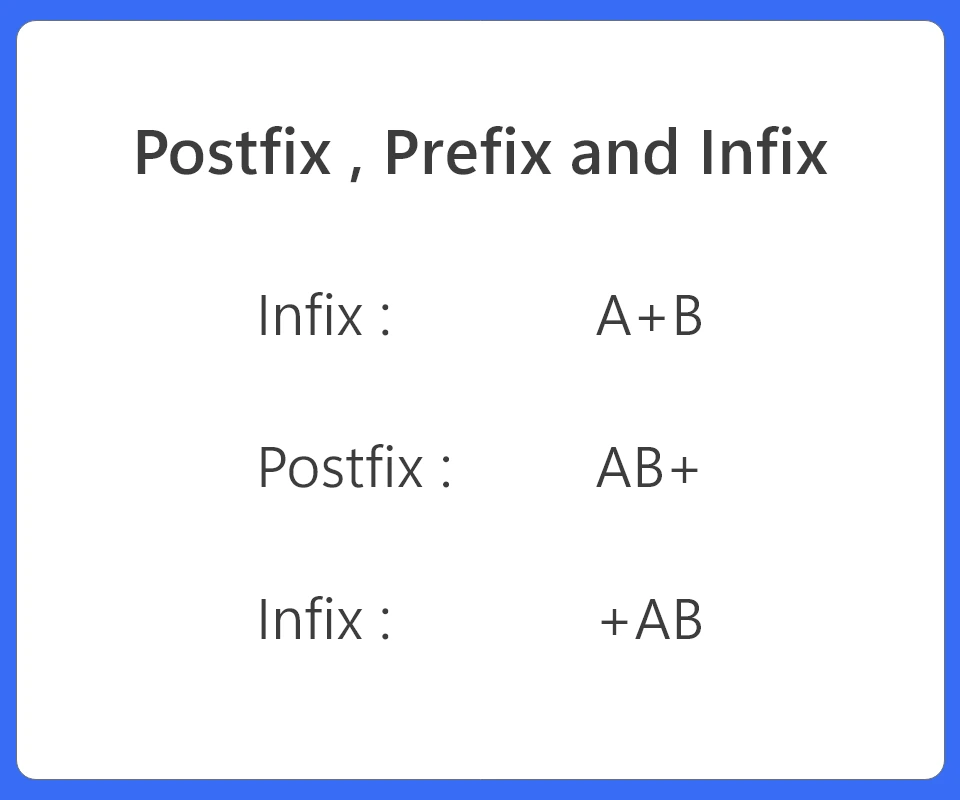Infix Prefix Postfix Conversion (Stack)

Why we use Postfix Prefix & Infix?
Introduction
- Operation : Any Expression of algebraic format (Example : A + B)
- Operands : A and B or 5 & 6 are operands
- Operators : +. -, %,*,/ etc are operators
Infix Notation
Infix is the day to day notation that we use of format A + B type. The general form can be classified as (a op b) where a and b are operands(variables) and op is Operator.
- Example 1 : A + B
- Example 2 : A * B + C / D
Postfix Notation
Postfix is notation that compiler uses/converts to while reading left to right and is of format AB+ type. The general form can be classified as (ab op) where a and b are operands(variables) and op is Operator.
- Example 1 : AB+
- Example 2 : AB*CD/+
Prefix Notation
Prefix is notation that compiler uses/converts to while reading right to left (some compilers can also read prefix left to right) and is of format +AB type. The general form can be classified as (op ab) where a and b are operands(variables) and op is Operator.
- Example 1 : +AB
- Example 2 : +*AB/CD

Why Postfix/Prefix Expressions are faster than Infix?
For Infix Expression which is format A+B*C, if the compiler is reading left to right then it can’t evaluate A+B first until it has read whole expression and knows expression is actually A + (B*C) i.e. B * C needs to be implemented first
Postfix for above infix is ABC*+. Now, as soon as compiler sees two operands followed by operator it can implement it without caring for precedence.
- Assume ABC*+
- ABC*+ (BC* is implemented as B*C and result is put back)
- AX+ (Assuming X stores result of BC* i.e. B*C)
- Now finally AX+ can be implemented as A+X
Compiler converts infix expression to postfix/prefix at compile time, so at runtime your calculations are always happening in post-prefix. A website's code maybe compiled once a week but it may need to run 1 million times a week.
Which is why we prefer that runtime execution should be as fast as possible. If calculations happen faster than we have optimized our page load time hugely right?
Problem (This is how to convert manually for MCQ Question in the exam)
Problem
- Infix:
a + b * c + dcan be written asa + (b * c) + d - Now, for all + – / * associativity is left to right we will write it as
(a + (b * c)) + dand thus further((a + (b * c)) + d)- Solving and converting innermost bracket to postfix
- Step 1 –
((a + bc*)+ d) - Step 2 – Consider
bc*as separate operandxthe innermost bracket now looks like((a + x)+ d)- Applying postfix it looks like –
(ax+ + d)replacing x here(abc*+ + d)
- Applying postfix it looks like –
- Step 3 – Considering
abc*+as separate operand z, the final bracket looks like –(z + d)the result would bezd+- replacing z value =
abc*+d+
- replacing z value =
Alert
The above may give wrong results sometimes, which is why its always safer to use below algorithm for both coding and manual calculation -Also note below algorithm is given wrong on Geeks4Geek website, only refer from here.(As most codes are made by interns and PrepInsta pages are made by Ph.D Teachers)
Algorithm (For Code/Manual Calculation)
- First Start scanning the expression from left to right
- If the scanned character is an operand, output it, i.e. print it
- Else
- If the precedence of the scanned operator is higher than the precedence of the operator in the stack(or stack is empty or has'(‘), then push operator in the stack
- Else, Pop all the operators, that have greater or equal precedence than the scanned operator. Once you pop them push this scanned operator. (If we see a parenthesis while popping then stop and push scanned operator in the stack)
- If the scanned character is an ‘(‘, push it to the stack.
- If the scanned character is an ‘)’, pop the stack and output it until a ‘(‘ is encountered, and discard both the parenthesis.
- Now, we should repeat the steps 2 – 6 until the whole infix i.e. whole characters are scanned.
- Print output
- Do the pop and output (print) until stack is not empty

Infix to Prefix
Problem (This is how to convert manually for MCQ Question in the exam)
- Infix:
(a / b + c) - ( d + e * f)can be written as((a / b) + c) - ( d + (e * f)) - Now, we have done the above according to associativity
- Solving and converting innermost bracket to prefix
- Step 1 –
(/ab + c) - ( d + *ef) - Step 2 – Consider
/aband*efas separate operandxandy - the innermost bracket now looks like
(x + c) - (d + y)- Applying prefix it looks like –
(+xc - +dy)replacing x and y here(+/abc - +d*ef)
- Applying prefix it looks like –
- Step 3 – Considering
+/abcand+d*efas separate operand z and w, the final bracket looks like –(z - w)the result would be-zw- replacing z and w value =
-+/abc+d*ef
- replacing z and w value =
Alert
The above may give wrong results sometimes, which is why its always safer to use below algorithm for both coding and manual calculation -Also note below algorithm is given wrong on Geeks4Geek website, only refer from here.(As most codes are made by interns and PrepInsta pages are made by Ph.D Teachers)
Algorithm (For Code/Manual Calculation)
Given Infix - ((a/b)+c)-(d+(e*f))
- Step 1: Reverse the infix string. Note that while reversing the string you must interchange left and right parentheses.
- Step 2: Obtain the postfix expression of the expression obtained from Step 1.
- Step 3: Reverse the postfix expression to get the prefix expression
This is how you convert manually for theory question in the exam
-
- String after reversal – ))f*e(+d(-)c+)b/a((
- String after interchanging right and left parenthesis – ((f*e)+d)-(c+(b/a))
- Apply postfix – Below is postfix (On this page you check infix to postfix conversion rule)
- Reverse Postfix Expression (Given After the image below)
| Sr. No. | Expression | Stack | Prefix |
|---|---|---|---|
| 0 | ( | ( | |
| 1 | ( | (( | |
| 2 | f | (( | f |
| 3 | * | ((* | f |
| 4 | e | ((* | fe |
| 5 | ) | ( | fe* |
| 6 | + | (+ | fe* |
| 7 | d | (+ | fe*d |
| 8 | ) | fe*d+ | |
| 9 | – | – | fe*d+ |
| 10 | ( | -( | fe*d+ |
| 11 | c | -( | fe*d+c |
| 12 | + | -(+ | fe*d+c |
| 13 | ( | -(+( | fe*d+c |
| 14 | b | -(+( | fe*d+cb |
| 15 | / | -(+(/ | fe*d+cb |
| 16 | a | -(+(/ | fe*d+cba |
| 17 | ) | -(+ | fe*d+cba/ |
| 18 | ) | – | fe*d+cba/+ |
| 19 | fe*d+cba/+- |
Final prefix: -+/abc+d*ef
Prime Course Trailer
Related Banners
Get PrepInsta Prime & get Access to all 200+ courses offered by PrepInsta in One Subscription
Get over 200+ course One Subscription
Courses like AI/ML, Cloud Computing, Ethical Hacking, C, C++, Java, Python, DSA (All Languages), Competitive Coding (All Languages), TCS, Infosys, Wipro, Amazon, DBMS, SQL and others
Stacks
- Introduction to Stack in Data Structure
Click Here - Operations on a Stack
Click Here - Stack: Infix, Prefix and Postfix conversions
Click Here - Stack Representation in –
C | C++ | Java - Representation of a Stack as an Array. –
C | C++ | Java - Representation of a Stack as a Linked List. –
C | C++ | Java - Infix to Postfix Conversion –
C | C++ | Java - Infix to prefix conversion in –
C | C++ | Java - Postfix to Prefix Conversion in –
C | C++ | Java
Queues
- Queues in Data Structures (Introduction)
Click Here - Queues Program in C and implementation
Click Here - Implementation of Queues using Arrays | C Program
Click Here - Types of Queues in Data Structure
Click Here - Application of Queue Data Structure
Click Here - Insertion in Queues Program (Enqueuing) –
C | C++ | Java - Deletion (Removal) in Queues Program(Dequeuing) –
C | C++ | Java - Reverse a Queue –
C | C++ | Java - Queues using Linked Lists –
C | C++ | Java - Implement Queue using Stack –
C | C++ | Java - Implement Queue using two Stacks –
C | C++ | Java
Circular Queues
- Circular queue in Data Structure
Click Here - Applications of Circular Queues
Click Here - Circular queue in –
C | C++ | Java - Circular queue using Array –
C | C++ | Java - Circular Queue using Linked Lists –
C | C++ | Java
Priority Queue
Stacks
- Introduction to Stack in Data Structure
- Operations on a Stack
- Stack: Infix, Prefix and Postfix conversions
- Stack Representation in – C | C++ | Java
- Representation of a Stack as an Array. – C | C++ | Java
- Representation of a Stack as a Linked List. – C | C++ | Java
- Infix to Postfix Conversion – C | C++ | Java
- Infix to prefix conversion in – C | C++ | Java
- Postfix to Prefix Conversion in – C | C++ | Java
Queues
- Queues in Data Structures (Introduction)
- Queues Program in C and implementation
- Implementation of Queues using Arrays | C Program
- Types of Queues in Data Structure
- Application of Queue Data Structure
- Insertion in Queues Program (Enqueuing) – C | C++ | Java
- Deletion (Removal) in Queues Program(Dequeuing) – C | C++ | Java
- Reverse a Queue – C | C++ | Java
- Queues using Linked Lists – C | C++ | Java
- Implement Queue using Stack – C | C++ | Java
- Implement Queue using two Stacks – C | C++ | Java
Circular Queues
- Circular queue in Data Structure
- Applications of Circular Queues
- Circular queue in – C | C++ | Java
- Circular queue using Array – C | C++ | Java
- Circular Queue using Linked Lists – C | C++ | Java

 0
0



Login/Signup to comment